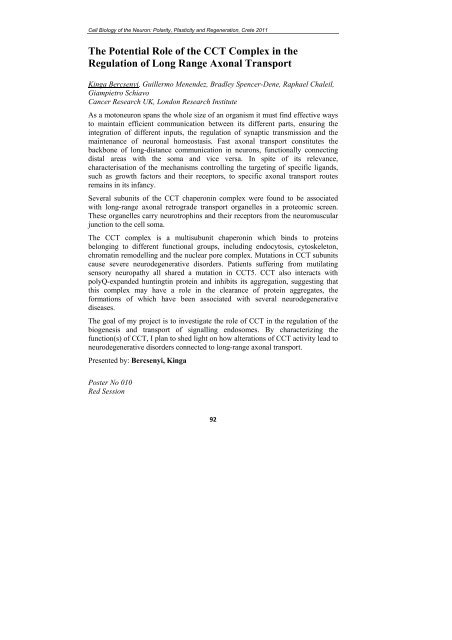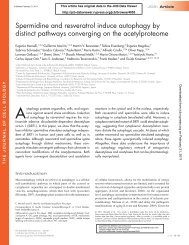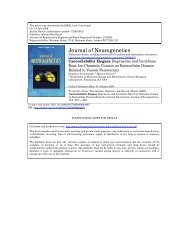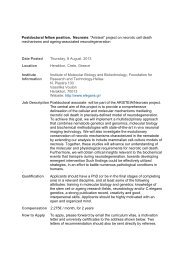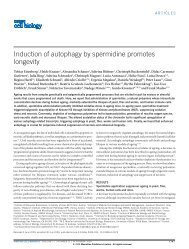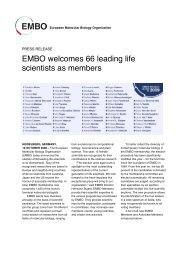CELL BIOLOGY OF THE NEURON Polarity ... - Tavernarakis Lab
CELL BIOLOGY OF THE NEURON Polarity ... - Tavernarakis Lab
CELL BIOLOGY OF THE NEURON Polarity ... - Tavernarakis Lab
Create successful ePaper yourself
Turn your PDF publications into a flip-book with our unique Google optimized e-Paper software.
Cell Biology of the Neuron: <strong>Polarity</strong>, Plasticity and Regeneration, Crete 2011<br />
The Potential Role of the CCT Complex in the<br />
Regulation of Long Range Axonal Transport<br />
Kinga Bercsenyi, Guillermo Menendez, Bradley Spencer-Dene, Raphael Chaleil,<br />
Giampietro Schiavo<br />
Cancer Research UK, London Research Institute<br />
As a motoneuron spans the whole size of an organism it must find effective ways<br />
to maintain efficient communication between its different parts, ensuring the<br />
integration of different inputs, the regulation of synaptic transmission and the<br />
maintenance of neuronal homeostasis. Fast axonal transport constitutes the<br />
backbone of long-distance communication in neurons, functionally connecting<br />
distal areas with the soma and vice versa. In spite of its relevance,<br />
characterisation of the mechanisms controlling the targeting of specific ligands,<br />
such as growth factors and their receptors, to specific axonal transport routes<br />
remains in its infancy.<br />
Several subunits of the CCT chaperonin complex were found to be associated<br />
with long-range axonal retrograde transport organelles in a proteomic screen.<br />
These organelles carry neurotrophins and their receptors from the neuromuscular<br />
junction to the cell soma.<br />
The CCT complex is a multisubunit chaperonin which binds to proteins<br />
belonging to different functional groups, including endocytosis, cytoskeleton,<br />
chromatin remodelling and the nuclear pore complex. Mutations in CCT subunits<br />
cause severe neurodegenerative disorders. Patients suffering from mutilating<br />
sensory neuropathy all shared a mutation in CCT5. CCT also interacts with<br />
polyQ-expanded huntingtin protein and inhibits its aggregation, suggesting that<br />
this complex may have a role in the clearance of protein aggregates, the<br />
formations of which have been associated with several neurodegenerative<br />
diseases.<br />
The goal of my project is to investigate the role of CCT in the regulation of the<br />
biogenesis and transport of signalling endosomes. By characterizing the<br />
function(s) of CCT, I plan to shed light on how alterations of CCT activity lead to<br />
neurodegenerative disorders connected to long-range axonal transport.<br />
Presented by: Bercsenyi, Kinga<br />
Poster No 010<br />
Red Session<br />
92


